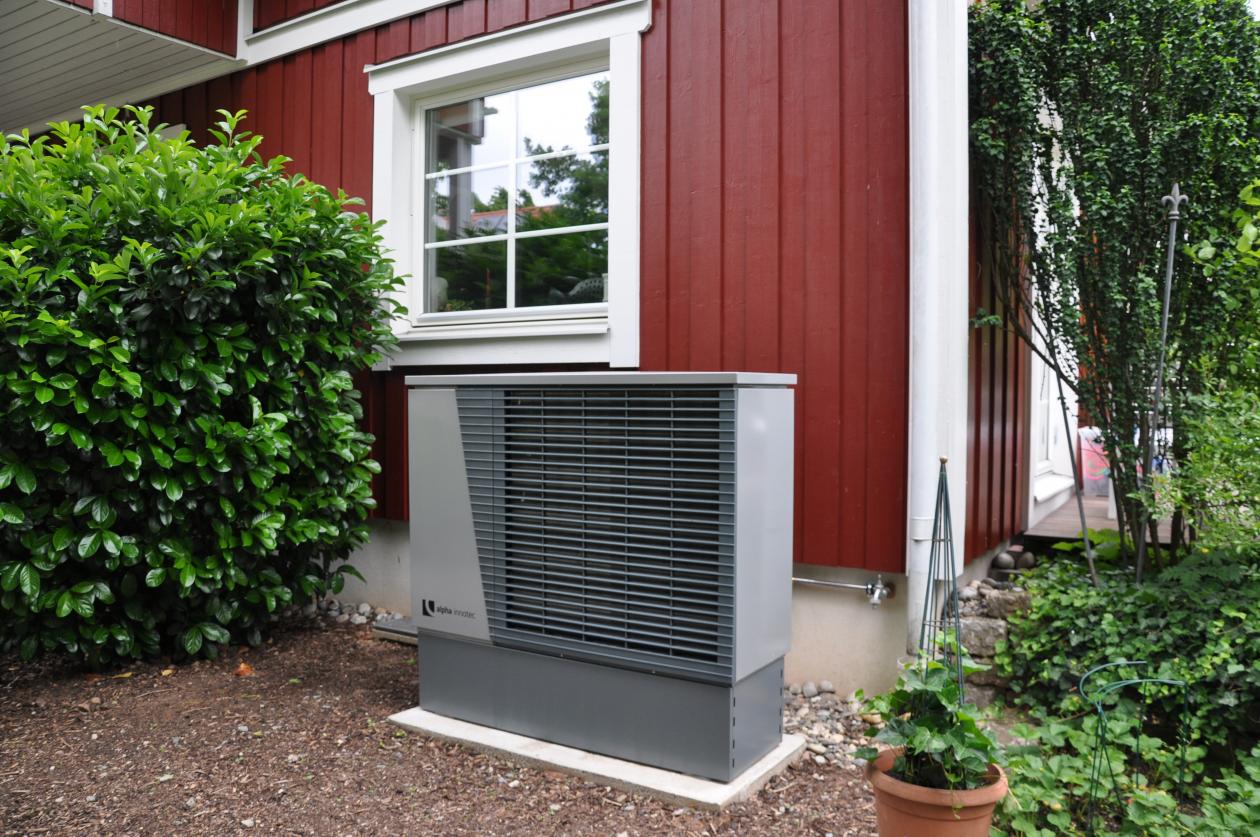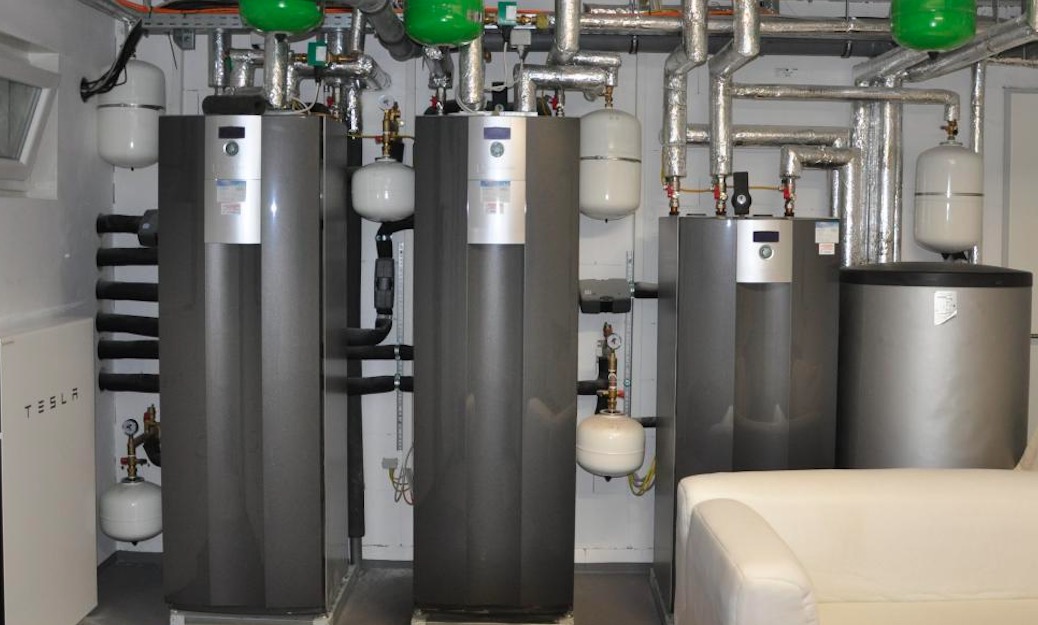Heat pumps basically work on the refrigerator principle, but the way they are utilized is the opposite. The purpose of the refrigerator is to cool food and drinks, whereas with the heat pump, the purpose is to heat a building or space.
While the refrigerator and the food and drinks inside the refrigerator are cooled, the space outside the refrigerator heats the room. The heat pump, on the other hand, cools the environment (outside air, soil or groundwater) and heats the building in an environmentally friendly and economical way.Thanks to it, you benefit from the energy storage around your home: you use free solar energy stored in the air, on the ground and in groundwater.
The heat pump system takes advantage of this stored energy and uses this free energy to heat your home or water.
You get your free heating energy from the environment.
The heat pump consumes an average of 2 – 4 kWh of electrical energy, depending on the application and source / heating system temperature level, to generate 10 kWh of heat energy. This means that the heat pump can generate 2-6 units of heat energy from 1 unit of electrical energy.
A standard electric heater can produce 1 unit of heat energy by using 1 unit of electrical energy. This utilization rate is called COP (coefficient of performance) and refers to efficiency.Accordingly, the COP value of a standard electric heater is 1, while the COP value of the heat pump is between 3-6.
Heat pump is 2 to 6 times more economical than conventional electrical heating system.
This saving rate depends on the type of heat pump, environmental conditions (air, soil or ground water temperature) and the type of heating system (underfloor heating system, radiator system, etc.).
The heat pump is also a cooling machine and we use heatpump to cool our houses in Summer
Heatpumps presents 3 functions (heating, cooling and water) in 1 device
Air to Water Heat Pumps

In the air source heat pump; outside air is sucked and the absorbed heat energy is transferred into the building by the heat pump. Thus, building or water heating is provided.
Considering all types of heat pumps, the air source heat pump is the most advantageous in terms of initial investment cost.
Because outside air is abundant everywhere, it is also extremely easy to access this energy source in structural terms. No special permission is required. In addition, air source heat pumps are now very efficient.
Air source heat pump is the most widely used type of heat pump in Turkey. Depending on the model, it can be easily preferred in radiator systems, as flow temperatures up to 70 oC can be reached.
Brine to Water Heat Pumps
In the ground source heat pump, the soil is cooled (heat is drawn) and this absorbed heat energy is transferred to the building with the help of the heat pump. Thus, building or water heating is provided.
The ground source heat pump is more efficient than the air source heat pump. In terms of initial investment cost, it is higher due to underground piping.
An important energy store in our nature is the soil. It is possible to benefit from the heat energy stored by the soil in two different ways.
If the garden area is sufficient, the heat energy of the soil is utilized by laying plastic polyethylene pipes approximately 1-2 meters deep in the soil. The cooling that will occur in the soil around the pipes does not harm the plants. However, it is recommended not to plant deep rooted plants near the pipes. Regeneration of the heated soil takes place in spring and summer thanks to the increase in solar radiation and rainfall.

Thus, the soil becomes ready for the heating season. The soil excavation and transportation required for the installation of heat pumps in new buildings is not expensive. Same operations cost more for existing buildings. The amount of heat energy that can be gained from the soil depends on some factors. Especially the type of soil is very important. For example, moist clay soil is very suitable as a heat source.
If the garden area is not sufficient, it is necessary to drill wells deep into the soil and place a special strength polyethylene pipe in these wells.
It is very important to determine the depths of the wells in the drilling method. Soil thermal sensitivity test is very useful to determine how much heat energy we can absorb at what depths. Experience values are available regarding the amount of heat that can be drawn.
Ground source heat pump is a heat pump type used in Turkey less, is present in the range of 5 to 200 kW. Depending on the model, it can be easily preferred in radiator systems, as flow temperatures up to 70 oC can be reached.
The ground source heat pump is also a refrigeration machine. In that case, we can cool the building by operating the heat pump in reverse in the summer season. In the well application of the ground source heat pump, natural cooling (without starting the heat pump) can also be performed by using the cold temperature level in the well.
Auxiliary Handbook for Ground Source Heat Pumps Installation:Water to Water Heat Pumps
In the water source heat pump, ground water is cooled (heat is drawn) and this withdrawn heat energy is transferred to the building with the help of the heat pump. Thus, building or water heating is provided. The water source heat pump is more efficient than the air and ground source heat pumps, even the most efficient type of heat pump. Like the soil, water is a resource that stores heat energy very well. Even in the coldest winter conditions, the temperature of the groundwater is between 7 and 12 ° C. Groundwater is taken from a source by a pump and brought to the evaporator of the water source heat pump. Then the heat energy of the water is drawn in the heat pump and the water cools and returns to the source. However, in order for this system to work properly, the flow rate of groundwater and the quality of water should be questioned beforehand. Only in this way can it be understood whether sufficient amount of heat energy can be withdrawn. The quality of the water must remain within the limits set by the heat pump manufacturer. If these limits are exceeded, it is recommended to use a suitable intermediate exchanger.

Because the heat exchangers in the heat pump are extremely sensitive to irregularities in the quality of the water. Different materials may be used in the heat exchangers (eg stainless steel or copper). Both exchanger materials may be sensitive to some elements found in water. In such cases, intermediate exchangers may be preferred. With the application of an intermediate exchanger made of suitable material, heat can be drawn from rivers such as river water, sea water. Water source heat pump is a heat pump type used in Turkey less, is present in the range of 5 to 200 kW. Depending on the model, it can be easily preferred in radiator systems, as flow temperatures up to 70 oC can be reached. With the professional simulation program, annual energy and CO savings can be determined by selecting the system and solar collector. Below is a sample account for your information.
| Criteria | Brine to Water Heat Pumps (Drilling) | Brine to Water Heat Pumps (Laying) | Air to Water Heat Pumps | Air to Air Heat Pumps |
|---|---|---|---|---|
| Applicability | Easy | Empty Land is Needed | Easy | Water quality must be questioned |
| Average COP | COP = 4-5 | COP = 4-5 | COP = 3-4 | COP = 5-6 |
| Efficiency | High | High | Medium | Very High |
| Initial Setup Cost | High | High | Low | High |
| Maintenance Cost | Low | Low | Low | Medium |
| Passive Cooling | Possible | Possible | – | Possible |
| Active Cooling | Possible | Possible | Possible | Possible |


